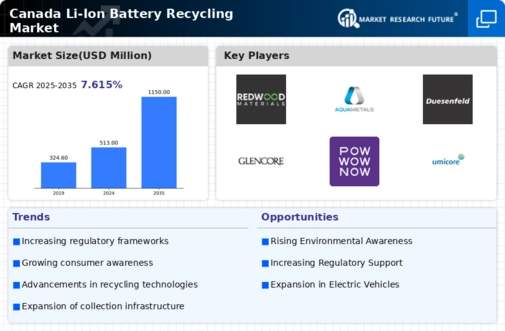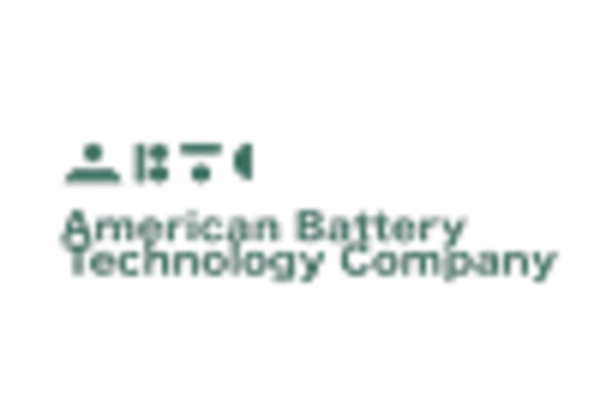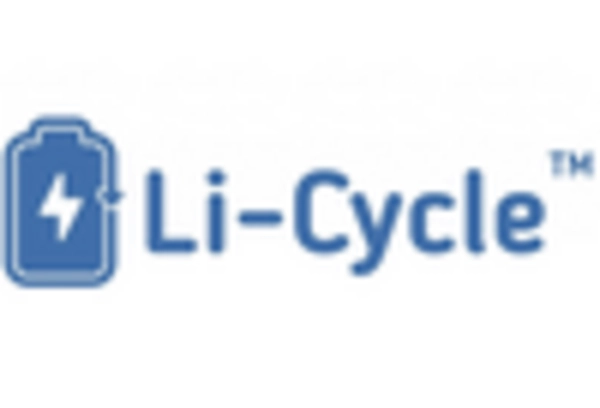Growing Environmental Concerns
Environmental concerns are increasingly driving the li ion-battery-recycling market in Canada. With the rising awareness of the ecological impact of battery waste, there is a growing push for sustainable practices. The Canadian public is becoming more conscious of the need to recycle batteries to prevent hazardous materials from contaminating landfills. Reports indicate that improper disposal of lithium-ion batteries can lead to significant environmental damage, prompting calls for better recycling solutions. This heightened awareness is likely to result in increased participation in recycling programs, thereby expanding the li ion-battery-recycling market as consumers seek responsible disposal options.
Government Incentives and Policies
Government initiatives play a crucial role in shaping the li ion-battery-recycling market in Canada. Various federal and provincial programs are being implemented to promote recycling and reduce environmental impact. For instance, the Canadian government has introduced financial incentives for companies that engage in battery recycling, which could potentially increase recycling rates by up to 30% by 2027. Additionally, policies aimed at reducing landfill waste and promoting circular economy practices are likely to bolster the market. These incentives not only encourage recycling but also stimulate innovation in recycling technologies, thereby enhancing the overall efficiency of the li ion-battery-recycling market.
Rising Demand for Electric Vehicles
The increasing adoption of electric vehicles (EVs) in Canada is a pivotal driver for the li ion-battery-recycling market. As the Canadian government aims to have 100% of new light-duty vehicle sales be zero-emission by 2035, the demand for lithium-ion batteries is expected to surge. This transition is projected to create a substantial volume of used batteries that require recycling. In 2023, it was estimated that the number of EVs on Canadian roads would exceed 1 million, leading to a significant increase in battery waste. Consequently, the li ion-battery-recycling market is likely to expand to accommodate the growing need for sustainable disposal and recovery of valuable materials from these batteries.
Collaboration Between Industry Stakeholders
Collaboration among various stakeholders in the li ion-battery-recycling market is emerging as a key driver. Partnerships between manufacturers, recyclers, and government agencies are fostering a more integrated approach to battery recycling. These collaborations can lead to the development of standardized recycling protocols and shared resources, which may enhance the efficiency of recycling operations. For instance, joint ventures between automotive manufacturers and recycling firms are likely to streamline the collection and processing of used batteries. This cooperative effort could potentially increase the overall recycling rate in Canada, thereby strengthening the li ion-battery-recycling market.
Technological Advancements in Recycling Processes
Technological advancements are significantly influencing the li ion-battery-recycling market. Innovations in recycling processes, such as hydrometallurgical and pyrometallurgical methods, are enhancing the efficiency of material recovery from spent batteries. These technologies can potentially recover up to 95% of valuable materials like lithium, cobalt, and nickel, which are essential for new battery production. As these processes become more refined and cost-effective, they are likely to attract investment and increase the capacity of recycling facilities across Canada. This trend suggests a promising future for the li ion-battery-recycling market, as improved technologies may lead to higher recovery rates and lower environmental impact.

















Leave a Comment